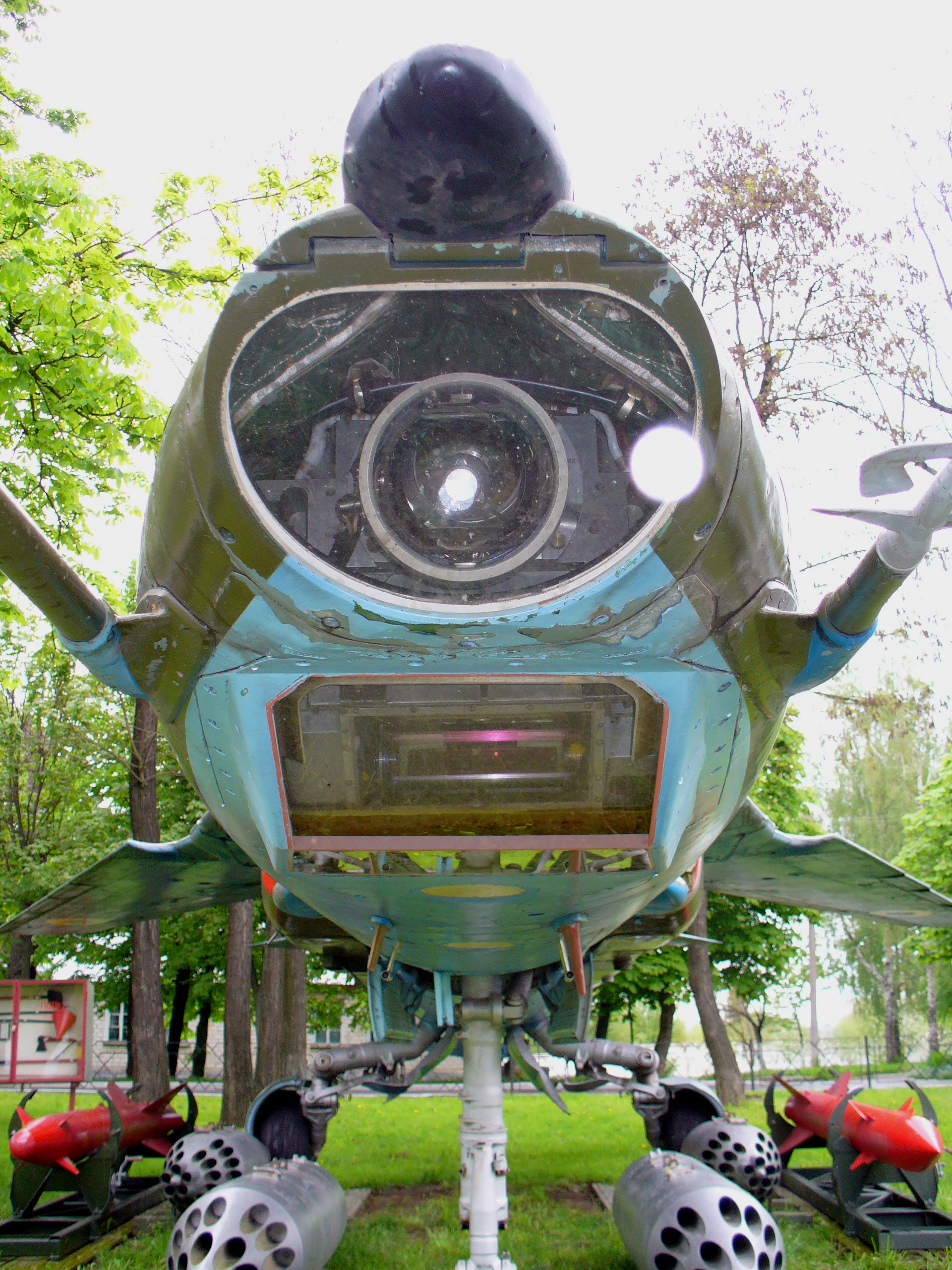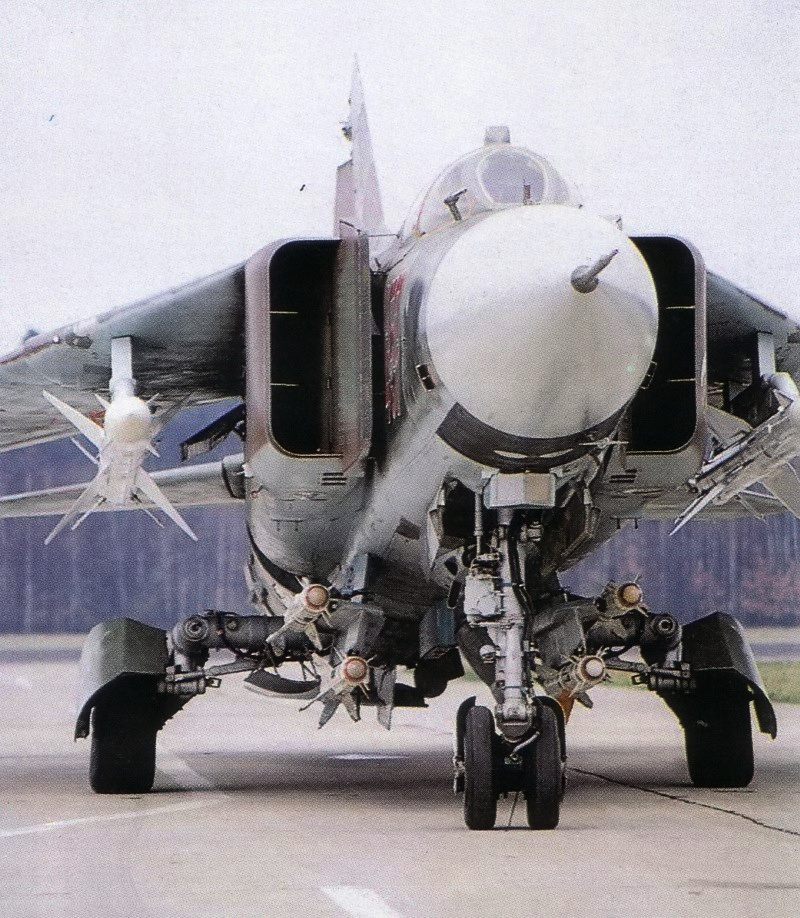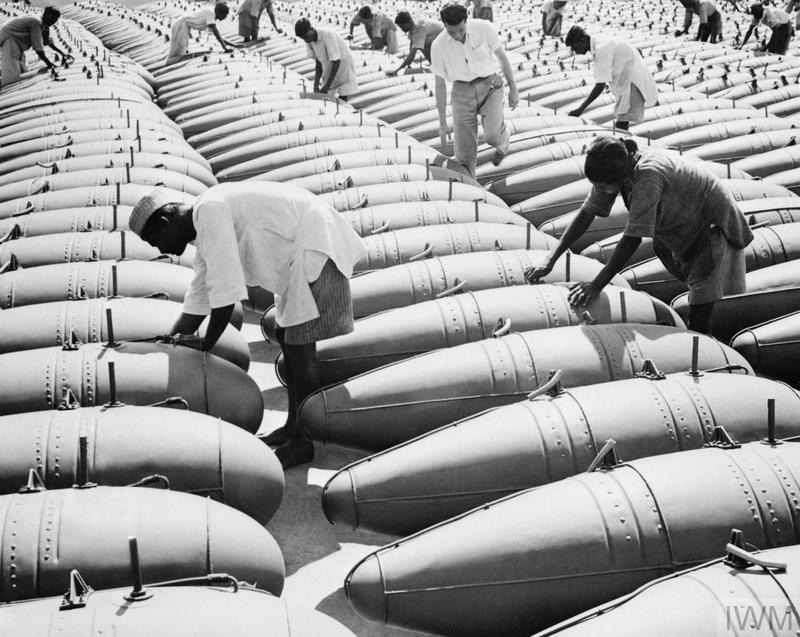|
MiG-27
The Mikoyan MiG-27 (russian: Микоян МиГ-27; NATO reporting name: Flogger-D/J) is a variable-sweep ground-attack aircraft, originally built by the Mikoyan-Gurevich design bureau in the Soviet Union and later licence-produced in India by Hindustan Aeronautics as the ''Bahadur'' ("Valiant"). It is based on the Mikoyan-Gurevich MiG-23 fighter aircraft, but optimised for air-to-ground attack. Unlike the MiG-23, the MiG-27 did not have widespread use outside Russia, as most countries opted for the Mikoyan-Gurevich MiG-23BN and Sukhoi Su-22 instead. It remains in service only with the Kazakh Air Forces in the ground attack role. All Russian, Indian, Sri Lankan and Ukrainian MiG-27s have been retired. Design and development The MiG-27 shares the basic airframe of the MiG-23, but with a revised nose – nicknamed "''Utkonos''" ("Platypus") or "'' Krokodil Gena''" in Russian service, first introduced on the MiG-23B. Dissatisfaction with the MiG-23BN led to the further d ... [...More Info...] [...Related Items...] OR: [Wikipedia] [Google] [Baidu] |
Mikoyan-Gurevich MiG-23
The Mikoyan-Gurevich MiG-23 (russian: Микоян и Гуревич МиГ-23; NATO reporting name: Flogger) is a variable-geometry fighter aircraft, designed by the Mikoyan-Gurevich design bureau in the Soviet Union. It is a third-generation jet fighter, alongside similar Soviet aircraft such as the Su-17 "Fitter". It was the first Soviet fighter to field a look-down/shoot-down radar, the RP-23 Sapfir, and one of the first to be armed with beyond-visual-range missiles. Production started in 1969 and reached large numbers with over 5,000 aircraft built, making it the most produced variable-sweep wing aircraft in history. Today the MiG-23 remains in limited service with some export customers. The basic design was also used as the basis for the Mikoyan MiG-27, a dedicated ground-attack variant. Among many minor changes, the MiG-27 replaced the MiG-23's nose-mounted radar system with an optical panel holding a laser designator and a TV camera. Development The MiG-23's ... [...More Info...] [...Related Items...] OR: [Wikipedia] [Google] [Baidu] |
Soviet Air Forces
The Soviet Air Forces ( rus, Военно-воздушные силы, r=Voyenno-vozdushnyye sily, VVS; literally "Military Air Forces") were one of the air forces of the Soviet Union. The other was the Soviet Air Defence Forces. The Air Forces were formed from components of the Imperial Russian Air Service in 1917, and faced their greatest test during World War II. The groups were also involved in the Korean War, and dissolved along with the Soviet Union itself in 1991–92. Former Soviet Air Forces' assets were subsequently divided into several air forces of former Soviet republics, including the new Russian Air Force. "March of the Pilots" was its song. Origins The ''All-Russia Collegium for Direction of the Air Forces of the Old Army'' (translation is uncertain) was formed on 20 December 1917. This was a Bolshevik aerial headquarters initially led by Konstantin Akashev. Along with a general postwar military reorganisation, the collegium was reconstituted as the "Workers' ... [...More Info...] [...Related Items...] OR: [Wikipedia] [Google] [Baidu] |
Kazakh Air Force
, image = Coa vvsrk.svg , image_size = 200px , caption = Emblem of the Kazakh Air Defence Forces , start_date = , country = , allegiance = , branch = , type = Air force , role = , size = 12,000 airman , command_structure = Kazakh Armed Forces , garrison = Astana , garrison_label = Headquarters , nickname = , patron = , motto = , colours = , colours_label = , march = , mascot = , anniversaries = , equipment = , equipment_label = , battles = , decorations ... [...More Info...] [...Related Items...] OR: [Wikipedia] [Google] [Baidu] |
Indian Air Force
The Indian Air Force (IAF) is the air arm of the Indian Armed Forces. Its complement of personnel and aircraft assets ranks third amongst the air forces of the world. Its primary mission is to secure Indian airspace and to conduct aerial warfare during armed conflict. It was officially established on 8 October 1932 as an auxiliary air force of the British Empire which honoured India's aviation service during World War II with the prefix ''Royal''. After India gained independence from United Kingdom in 1947, the name Royal Indian Air Force was kept and served in the name of Dominion of India. With the government's transition to a Republic in 1950, the prefix ''Royal'' was removed. Since 1950, the IAF has been involved in four wars with neighbouring Pakistan. Other major operations undertaken by the IAF include Operation Vijay, Operation Meghdoot, Operation Cactus and Operation Poomalai. The IAF's mission expands beyond engagement with hostile forces, with the IAF partic ... [...More Info...] [...Related Items...] OR: [Wikipedia] [Google] [Baidu] |
Variable-sweep Wing
A variable-sweep wing, colloquially known as a "swing wing", is an airplane wing, or set of wings, that may be swept back and then returned to its original straight position during flight. It allows the aircraft's shape to be modified in flight, and is therefore an example of a variable-geometry aircraft. A straight wing is most efficient for low-speed flight, but for an aircraft designed for transonic or supersonic flight it is essential that the wing be swept. Most aircraft that travel at those speeds usually have wings (either swept wing or delta wing) with a fixed sweep angle. These are simple and efficient wing designs for high speed flight, but there are performance tradeoffs. One is that the stalling speed is increased, necessitating long runways (unless complex high-lift wing devices are built in). Another is that the aircraft's fuel consumption during subsonic cruise is higher than that of an unswept wing. These tradeoffs are particularly acute for naval carrier-base ... [...More Info...] [...Related Items...] OR: [Wikipedia] [Google] [Baidu] |
Sukhoi Su-7
The Sukhoi Su-7 ( NATO designation name: Fitter-A) is a swept wing, supersonic fighter aircraft developed by the Soviet Union in 1955. Originally, it was designed as a tactical, low-level dogfighter, but was not successful in this role. On the other hand, the soon-introduced Su-7B series became the main Soviet fighter-bomber and ground-attack aircraft of the 1960s. The Su-7 was rugged in its simplicity, but its Lyulka AL-7 engine had such high fuel consumption that it seriously limited the aircraft's payload, as even short-range missions required that at least two hardpoints be used to carry drop tanks rather than ordnance. Design and development Original Su-7 fighters On 14 May 1953, after Joseph Stalin's death, the Sukhoi OKB was reopened"Sukhoi Su-7." ''Sukhoi Company Museum.'' Retrieved: 28 January 2011 and by the summer ... [...More Info...] [...Related Items...] OR: [Wikipedia] [Google] [Baidu] |
Gena The Crocodile
Gena the Crocodile (russian: links=no, Крокодил Гена, Krokodil Gena) is a fictional friendly crocodile in the series of animation films '' Gena the Crocodile'', '' Cheburashka'' and '' Shapoklyak'' by Roman Kachanov (Soyuzmultfilm studio). He debuted in the 1966 novel ''Gena the Crocodile and His Friends'' by Eduard Uspensky. The crocodile's name is a typical diminutive of the Russian male name Gennady. Gena and Cheburashka, also a title character in the series, are best friends. The 50-year-old Gena works in a zoo as an attraction (or, as the original novel's author Uspensky had put it, "Gena the Crocodile worked in a zoo as a crocodile"). In his spare time, he plays the garmon and likes to sing. His two best-known songs are "Pust' begut neuklyuzhe..." and "Goluboy vagon" ("The Blue Train Car"). One rainy day, which happens to be his birthday, Gena sings the song: "Let the pedestrians run clumsily over puddles..." ("Пусть бегут неуклюже пеше� ... [...More Info...] [...Related Items...] OR: [Wikipedia] [Google] [Baidu] |
Hindustan Aeronautics
Hindustan Aeronautics Limited (HAL) is an Indian state-owned aerospace and defence company, headquartered in Bangalore, India. Established on 23 December 1940, HAL is one of the oldest and largest aerospace and defence manufacturers in the world today. HAL began aircraft manufacturing as early as 1942 with licensed production of Harlow PC-5, Curtiss P-36 Hawk and Vultee A-31 Vengeance for the Indian Air Force. HAL currently has 11 dedicated Research and development (R&D) centers and 21 manufacturing divisions under 4 production units spread across India. HAL is managed by a Board of Directors appointed by the President of India through the Ministry of Defence, Government of India. HAL is currently involved in designing and manufacturing of fighter jets, helicopters, jet engine and marine gas turbine engine, avionics, software development, spares supply, overhauling and upgrading of Indian military aircraft. The HAL HF-24 Marut fighter-bomber was the first indigenous fighter a ... [...More Info...] [...Related Items...] OR: [Wikipedia] [Google] [Baidu] |
WikiProject Aircraft
A WikiProject, or Wikiproject, is a Wikimedia movement affinity group for contributors with shared goals. WikiProjects are prevalent within the largest wiki, Wikipedia, and exist to varying degrees within Wikimedia project, sister projects such as Wiktionary, Wikiquote, Wikidata, and Wikisource. They also exist in different languages, and translation of articles is a form of their collaboration. During the COVID-19 pandemic, CBS News noted the role of Wikipedia's WikiProject Medicine in maintaining the accuracy of articles related to the disease. Another WikiProject that has drawn attention is WikiProject Women Scientists, which was profiled by ''Smithsonian Magazine, Smithsonian'' for its efforts to improve coverage of women scientists which the profile noted had "helped increase the number of female scientists on Wikipedia from around 1,600 to over 5,000". On Wikipedia Some Wikipedia WikiProjects are substantial enough to engage in cooperative activities with outside organization ... [...More Info...] [...Related Items...] OR: [Wikipedia] [Google] [Baidu] |
Landing Gear
Landing gear is the undercarriage of an aircraft or spacecraft that is used for takeoff or landing. For aircraft it is generally needed for both. It was also formerly called ''alighting gear'' by some manufacturers, such as the Glenn L. Martin Company. For aircraft, Stinton makes the terminology distinction ''undercarriage (British) = landing gear (US)''. For aircraft, the landing gear supports the craft when it is not flying, allowing it to take off, land, and taxi without damage. Wheeled landing gear is the most common, with skis or floats needed to operate from snow/ice/water and skids for vertical operation on land. Faster aircraft have retractable undercarriages, which fold away during flight to reduce drag. Some unusual landing gear have been evaluated experimentally. These include: no landing gear (to save weight), made possible by operating from a catapult cradle and flexible landing deck: air cushion (to enable operation over a wide range of ground obstacles and wa ... [...More Info...] [...Related Items...] OR: [Wikipedia] [Google] [Baidu] |
Nav/attack System
A nav/attack system (short for navigation/attack system) is an integrated suite of sensor A sensor is a device that produces an output signal for the purpose of sensing a physical phenomenon. In the broadest definition, a sensor is a device, module, machine, or subsystem that detects events or changes in its environment and sends ...s and navigation equipment that allows a military aircraft to locate and attack specific ground targets or conduct aerial reconnaissance with a high degree of precision. Since the late 1950s, nav/attack systems helped pilots increase the accuracy of releasing ordnance. A computer program would record the aircraft's velocity and use it to pinpoint their location in relationship with the target's location. Early integrated nav/attack systems suffered from poor reliability. Improvements in digital computing technology, advent of the microchip, have resulted in substantially more sophisticated and effective equipment. A typical modern nav/attack ... [...More Info...] [...Related Items...] OR: [Wikipedia] [Google] [Baidu] |
Intake Ramp
An intake ramp is a rectangular, plate-like device within the air intake of a jet engine, designed to generate a number of shock waves to aid the inlet compression process at supersonic speeds. The ramp sits at an acute angle to deflect the intake air from the longitudinal direction. At supersonic flight speeds, the deflection of the air stream creates a number of oblique shock waves at each change of gradient along at the ramp. Air crossing each shock wave suddenly slows to a lower Mach number, thus increasing pressure. Ideally, the first oblique shock wave should intercept the air intake lip, thus avoiding air spillage and pre-entry drag on the outer boundary of the deflected streamtube. For a fixed geometry intake at zero incidence, this condition can only be achieved at one particular flight Mach number, because the angle of the shock wave (to the longitudinal direction) becomes more acute with increasing aircraft speed. More advanced supersonic intakes feature a ramp with ... [...More Info...] [...Related Items...] OR: [Wikipedia] [Google] [Baidu] |





